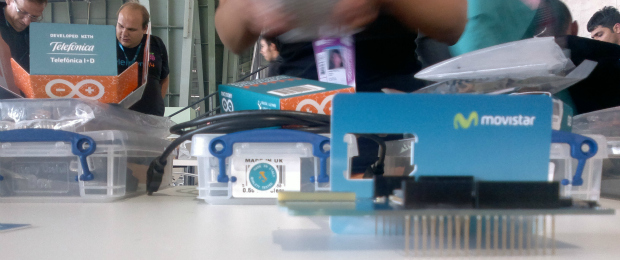A few weeks ago we told you about Arduino to mark the launch of Arduino GSM/GPRS Shield, a device with a GPRS/GSM connection launched by Arduino in collaboration with Telefónica. In the header you can see a photograph of the workshop that David Cuartielles, one of the founders of Arduino, coordinated during the Berlin Campus Party Europe.
Arduino is an open and versatile platform for the development of electronic products, especially aimed at an amateur audience (artists, electronics enthusiasts, etc.). Given the fact that it is free hardware, all of its designs are open and can be reused and even improved, but not everything is Arduino. Other platforms are appearing, many of them Arduino clones, and this situation opens up a whole host of possibilities for electronics buffs and for the general public, as their main characteristic is that they are very easy to program and very low-cost. We will be discussing a few of them below and comparing them with Arduino:
BeagleBone
BeagleBone is a small computer the size of a credit card from which you can run an operating system such as Linux/Android 4.0. The main difference between it and Arduino is that it can run a small operating system, thereby practically converting it into a minicomputer that can run programs on these operating systems. BeagleBone is designed to function at a much higher level and it has far more processing capacity than Arduino. The following link goes to a video that describes this device in greater detail.
Raspberry Pi
Raspberry Pi is a minicomputer, like BeagleBone. It is the size of a credit card, quite inexpensive (cheaper than BeagleBone, but more expensive than Arduino) and was developed in the UK by the Raspberry Pi Foundation with the main aim being to stimulate the teaching of computer sciences in schools. Being a minicomputer, it can be used for running considerably more complex things than Arduino and can use high-level programming languages such as Python, C++ and Java. Here is an example of what can be developed using this device:
Nanode
Nanode was developed by a British electronics engineer named Ken Boak, from the Hackerspace Group. Nanode is an evolved version of Arduino that enables the latter to be connected to the Internet via an API and can even be used as a simple web server allowing the user to configure the device. Just like Arduino, it is programmed using the same environment and is open-source. It can thus be programmed from any operating system (Mac, Linux and Windows). To be honest, the only obvious different between both devices is their price. Nanode costs less while providing the same quality and functionality.
Libelium Waspmote
Libelium Waspmote is a device designed for creating wireless sensor networks with a number of quite specific requirements and is intended to be deployed in a real scenario. I consider the aforementioned devices as something to “play around with” that makes it possible for you to develop things yourself and, most importantly, to learn to use electronics. As has already been mentioned, most of these devices are used in schools and universities for the small-scale development of networks or robots. Libelium Waspmote is marketed by a Spanish start-up recognized as an innovative company by different Spanish government institutions. One similarity between them is that Waspmote and Arduino use the same development environment code developed for an Arduino can also be used in this device simply by making a few small adjustments.
To sum up, I have commented on four alternatives to Arduino, two of which, BeagleBone y Raspeberry Pi, are far more powerful development platforms as they are small computers that enable us to develop considerably more complex things than we could develop using Arduino. Then there is Nanode, an extension of Arduino. The main difference between them, being that they both provide the same service, is that Nanode is less expensive. Lastly, Waspmote is a commercial product specifically designed for the development of the Internet of Things, but is compatible with any of the projects we can do in Arduino.
As you can see, there are many alternatives to Arduino that give us the opportunity to make very interesting things and at quite a low cost. If what you want to do is “tinker” around in this world, however, I would recommend you begin doing so via Arduino, as it is not only a platform that is very easy to understand and use, but there is also a huge supportive community that can help you out with any problem you might encounter and that will even be able to provide you with many examples and projects you might want to do.
Give it a try!!












